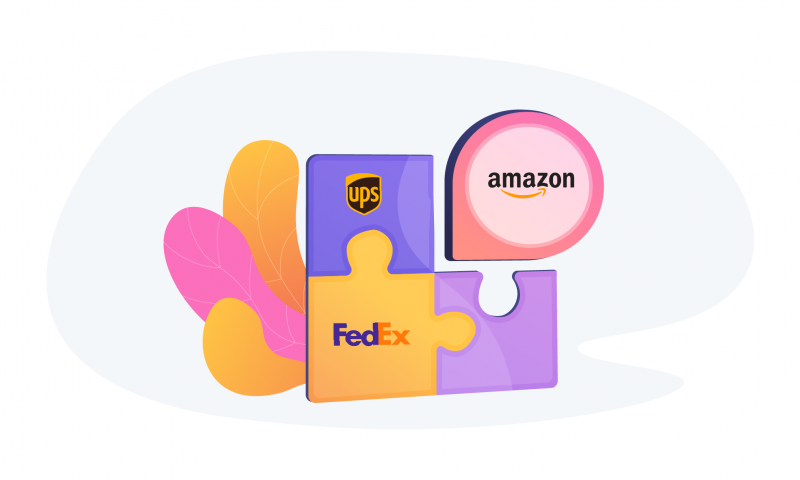“Always deliver more than expected” – Larry Page, Google
Why we would think Amazon is the biggest threat
The global logistics market is vast and fragmented. The first name that comes to mind when talking about shipping and logistics is FedEx but the second name, to no one’s surprise, is Amazon. Yes, Bezos’s brainchild that has taken the world by storm. But when did Amazon crawl and leap out of the shopping business and joined the delivery bandwagon? In 2014. From that year the retail giant accelerated the construction of its own distribution centres and began amassing fleets of semi-trucks, delivery vans and of course, cargo planes.
Fast forward to today, Amazon today is one of the biggest brands we know and is the third-largest courier in the US after UPS and USPS. It has been giving tough competition to FedEx, UPS, USPS and other global players in logistics for quite some time now. They changed the shipping game in 2005 with Amazon Prime and 2-day and same-day deliveries. It was in 2012 that Amazon acquired a provider of automated and robotic warehousing solutions. After that many big retailers followed the mega-retailer. Moreover, there are 35000 Amazon brands that make more than $1 Million in revenue. In the years 2020 and 2021, Amazon spent roughly $80 billion on logistics infrastructure and is all set to make its own cargo ships and shipping containers.
Does this make Amazon the biggest threat to giants like FedEx and UPS? A definite no.
The biggest threats are the customer-driven, technology-led, new-age local carriers.
Local carriers after the pandemic
When the pandemic hit in 2020, the world was gasping from every corner, desperately waiting for it to end. People wanted to go out, shop and live a normal life. For two years, everyone was masked up and still hoping for things to be normal. Retailers had no idea when their customers would receive their orders and carriers were just not sure. Ever Given, the mighty ship was stuck at Suez Canal for days and was perhaps the biggest example of the crumbling state of the supply chain back then.
But when the brick-and-mortar stores closed, people still wanted to shop and online shopping grew more than anyone could have imagined. What happened next was major warehouses quickly ran low on bestsellers and carriers ran low on capacity but the supply was still short because after all, the pandemic made it impossible to continue operations the way it did.
All this resulted in the freight shipping rates to some regions skyrocketing 443%. What helped the customers and catered to their every need were local carriers (gig economy fulfilment providers or last-mile carriers). Major retailers started outsourcing order fulfilment to local carriers and that’s the best decision they made. These carriers typically transport freight from 80-100 miles within what is called a commercial zone of a city or region as defined by the Surface Transportation Board (STB).
Local carriers may have a small fleet and operate in a smaller geographical area, but they will outperform carriers like Amazon because they know the market better than anyone else. They understand the needs of their customers, know exactly which products perform well and how the deliveries are and keep the best interests of their customers in mind. They provide a strong relationship and offer personalized services.
Local Carrier, FedEx and UPS
Local carriers account for 60% of the U.S. trucking industry. They are perfect for last-mile delivery. In peak shipping season, FedEx and UPS had to hold their shippers to limit how many packages the companies would accept. Consequently, many eCommerce store owners couldn’t make the profits they could have. What these local or regional carriers did was increase efficiency. By deploying a local carrier, eCommerce store owners would get more things shipped fast without the additional costs.
In the last few years, everyone has increased their rates. Be it USPS’s Priority Mail Service (3.1%) and Priority Mail Express (3.1%) or Pitney Bowes (5.9%). FedEx added additional handling and oversize surcharge and UPS introduced a new surcharge called UPS’ Remote Area Surcharge and nudged shippers towards a hearty mix of local and global carriers.
Source: global tranz
Adding local carriers lets retailers give options like same-day and two-day, with minimum shipping costs and fill their capacity requirements. Moreover, many important aspects of the logistics industry are very local in nature. Like short-haul trucking fleets which generally operate within a single city or region.
So, will the second-tier carrier will take over 3 PL?
FedEx’s Q1 2022
Information credit – csimarket
Source : Axios
After Covid, many things changed. Companies like FedEx and UPS implemented surcharges and thus prioritized more profitable deliveries.
Picture Credits – Shipware
Until now it’s pretty clear that when it comes to final-mile deliveries, local carriers are the way to go. But, will FedEx and larger 3 PLs actually fall behind these? Possibly. But not soon. Sure, they might be cheaper than the national carriers but it will take some time for local carriers to rise up and stand above the global giants. Right now, 3 PLs use local carriers for middle-mile and as second-tier carriers but soon enough these carriers will expand their services and with the added customer knowledge they have, the expansion will not be a problem.
The takeaway for your eCommerce brand
Local carriers are here to stay. Your customers expect deliveries at warp speed. Every global carrier – FedEx, UPS and more is adding a number of surcharges so the need of the hour is adding local carriers to the mix. This in turn solves the issue of rising shipping costs and stringent delivery timelines for small business owners. So, there is a win-win.
- Is Same-Day Delivery Right for Your Canadian eCommerce Business? - October 8, 2025
- Returns & Exchanges: A Practical Guide for Canadian Online Sellers - September 25, 2025
- Holiday Shipping Deadlines 2025 – Canada Post, FedEx, UPS - September 9, 2025






